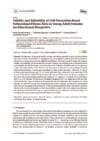In physical activity, testing procedures generally require maximal efforts. They are not always administrable or appropriate (e.g., with beginners, elderly, or in school); therefore, alternative submaximal procedures might be more fitting. This study aimed to assess the criterion validity and reliability of submaximal tests based on perceptual variables to be used instead of the corresponding maximal procedures to evaluate muscular endurance, flexibility, and cardiorespiratory fitness. The sustainability of this “educational” rationale to achieve the individual self-government and self-determination of testing and exercising has been further discussed. Methods: A total of 16 female gym practitioners (age 23 ± 3 years) performed five submaximal tests (push-up, S-PU; crunch, S-CR; wall-sit, S-WS; bending forward, S-BF; Step test, S-ST), whose results were compared to those from the corresponding maximal tests (push-up, PU; crunch, CR; wall-sit, WS; sit-and-reach, S&R; Yo-yo, YY). Results: The Interclass Correlation Coefficient (ICC) was higher than 0.8 in all of the submaximal tests. High correlations were found between all submaximal and maximal tests except between YY and S-ST, though their mean heart rates were correlated. Conclusions: Submaximal tests based on an internal load at about 50% of the maximal perceived exertion are equally valid and reliable to the corresponding gold-standard maximal tests, except for the cardiorespiratory evaluation. The educational rationale of this study supports self-acting as a calibration mechanism of physical activity, promoting a proper use of the body but not its overuse.

Related Research
-
Background The associations between cardiorespiratory fitness (CRF) and physical literacy in children are largely unknown. The aim of this study was to assess the relationships between CRF, measured using the 20-m shuttle run test (20mSRT), and components of physical literacy among Canadian children aged 8–12 years. Methods A total of 9393 (49.9% girls) children, with a mean (SD) age of…
-
Abstract: Body Dissatisfaction (BD) and low physical self-concept and exercise efficacy have been linked to poor physical fitness levels and adverse health outcomes in children. The purpose of this study was to examine the relationship between BD, physical fitness, exercise self-efficacy, and self-Perception of Physical Fitness (PFP) in Latina and Black female children. Twenty-eight Latina and Black children enrolled in…
-
Background English youth typically do not sufficiently engage in the types and intensities of physical activity that develop muscular fitness. The aim of this study was to use a combination of qualitative techniques to explore adolescent boys’ understanding, perceptions, and experiences of physical activity and the role muscular fitness plays within boys’ physically active lifestyles. Methods Focus group interviews with…


Responses